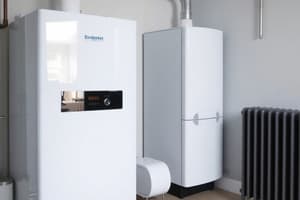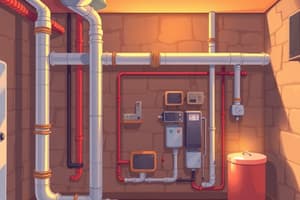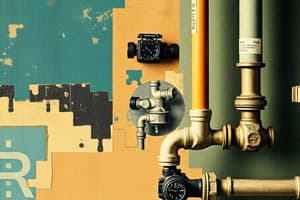Podcast
Questions and Answers
What type of joint is designed to be buried in the ground?
What type of joint is designed to be buried in the ground?
- A joint designed to be buried in the ground (correct)
- A connection between a cold tail and the heating element
- A compound-filled or encapsulated joint
- A joint made by welding
What is a characteristic of a joint made by welding, soldering, brazing or appropriate compression tool?
What is a characteristic of a joint made by welding, soldering, brazing or appropriate compression tool?
- It is designed to be buried in the ground
- It is maintenance-free
- It must be inspected regularly
- It is not accessible for inspection (correct)
What does the symbol (MF) indicate on a product?
What does the symbol (MF) indicate on a product?
- It is a low-voltage accessory
- It is a maintenance-intensive accessory
- It is a high-risk accessory
- It is a maintenance-free accessory (correct)
What is an exception to the accessibility requirement for inspection, testing, and maintenance?
What is an exception to the accessibility requirement for inspection, testing, and maintenance?
What is true about equipment complying with BS 5733 and marked with the symbol (MF)?
What is true about equipment complying with BS 5733 and marked with the symbol (MF)?
What type of connector is used in high-temperature applications?
What type of connector is used in high-temperature applications?
What is a crucial factor in selecting termination points?
What is a crucial factor in selecting termination points?
Where are porcelain connectors often found?
Where are porcelain connectors often found?
What type of terminal is used to connect fixed wiring to a totally enclosed fitting?
What type of terminal is used to connect fixed wiring to a totally enclosed fitting?
What is the purpose of a claw washer?
What is the purpose of a claw washer?
What is the process of erosion?
What is the process of erosion?
What can cause sparking and flashing in contacts?
What can cause sparking and flashing in contacts?
What happens to contacts when they open and close?
What happens to contacts when they open and close?
What is a result of erosion?
What is a result of erosion?
What is a primary requirement for every connection between conductors or between a conductor and other equipment?
What is a primary requirement for every connection between conductors or between a conductor and other equipment?
What type of contacts can cause surges?
What type of contacts can cause surges?
What factor should be considered when selecting the means of connection?
What factor should be considered when selecting the means of connection?
Why is it necessary to consider the temperature attained at the terminals in normal service?
Why is it necessary to consider the temperature attained at the terminals in normal service?
What is a specific consideration for soldered connections?
What is a specific consideration for soldered connections?
What is a common characteristic of terminals without the marking R, F, S, or Sol?
What is a common characteristic of terminals without the marking R, F, S, or Sol?
Why is it necessary to provide adequate locking arrangements in certain situations?
Why is it necessary to provide adequate locking arrangements in certain situations?
What type of conductor is marked with an 'R'?
What type of conductor is marked with an 'R'?
What type of conductor is marked with an 'F'?
What type of conductor is marked with an 'F'?
What type of conductor is marked with an 'S' or 'Sol'?
What type of conductor is marked with an 'S' or 'Sol'?
What is true about terminals with specific markings (R, F, S, or Sol)?
What is true about terminals with specific markings (R, F, S, or Sol)?
Flashcards are hidden until you start studying




